Scientists have captured an image of a relatively young planet found beyond the solar system, that can provide clues as how gas giants like Jupiter are formed and even have significant impacts to other planets in the same star system.
In order to detect this Jupiter-like exoplanet called 51 Eridani b, scientists have utilized the Gemini Planet Imager which is found on a telescope in Chile. The gas planet also orbits a young star some 96 light years away from Earth.
This exoplanet is almost double the size of Jupiter which is the largest gas giant in the solar system. It is also located in an orbital position in its star system which is similar to where Saturn is located in our solar system.
The 51 Eridani b is also one of the planets to be directly imaged. The exoplanet is still radiating heat that was produced from its formation some less than 20 million years ago which is now glowing, enshrouded by this infrared light, that was registered in the telescope's readings.
According to astronomer Bruce Macintosh from Stanford University, the exoplanet 51 Eri b provides an opportunity to examine and study further in detail a planet that is still undergoing effects from its initial forming conditions.
More analysis results revealed that the planet's atmospheric composition is mostly comprised of methane similar to Jupiter's where this can help scientists to decipher how gas giant planets form and evolve.
According to planetary scientist Travis Barman from the University of Arizona, considered as a young planet, 51 Eri b gives us a glimpse of how Jupiter would look like billions of years ago making this a pivotal piece in the planet formation jigsaw puzzle.
The exoplanets that astronomers were only able to directly observe and capture a direct image of them are only a handful where almost all of them are five to 13 times larger than Jupiter.
Other telescopes usually detect planets indirectly like NASA's Kepler Space Telescope that measures the planet's transit when it orbits around its parent star, meaning astronomers measure slight dimming of light from the stars when a planet is blocking the light path towards Earth. Other methods also include looking for starlight "wobbles" that are caused by gravitational forces of other orbiting planets near them.
This study is published in the journal, Science.


